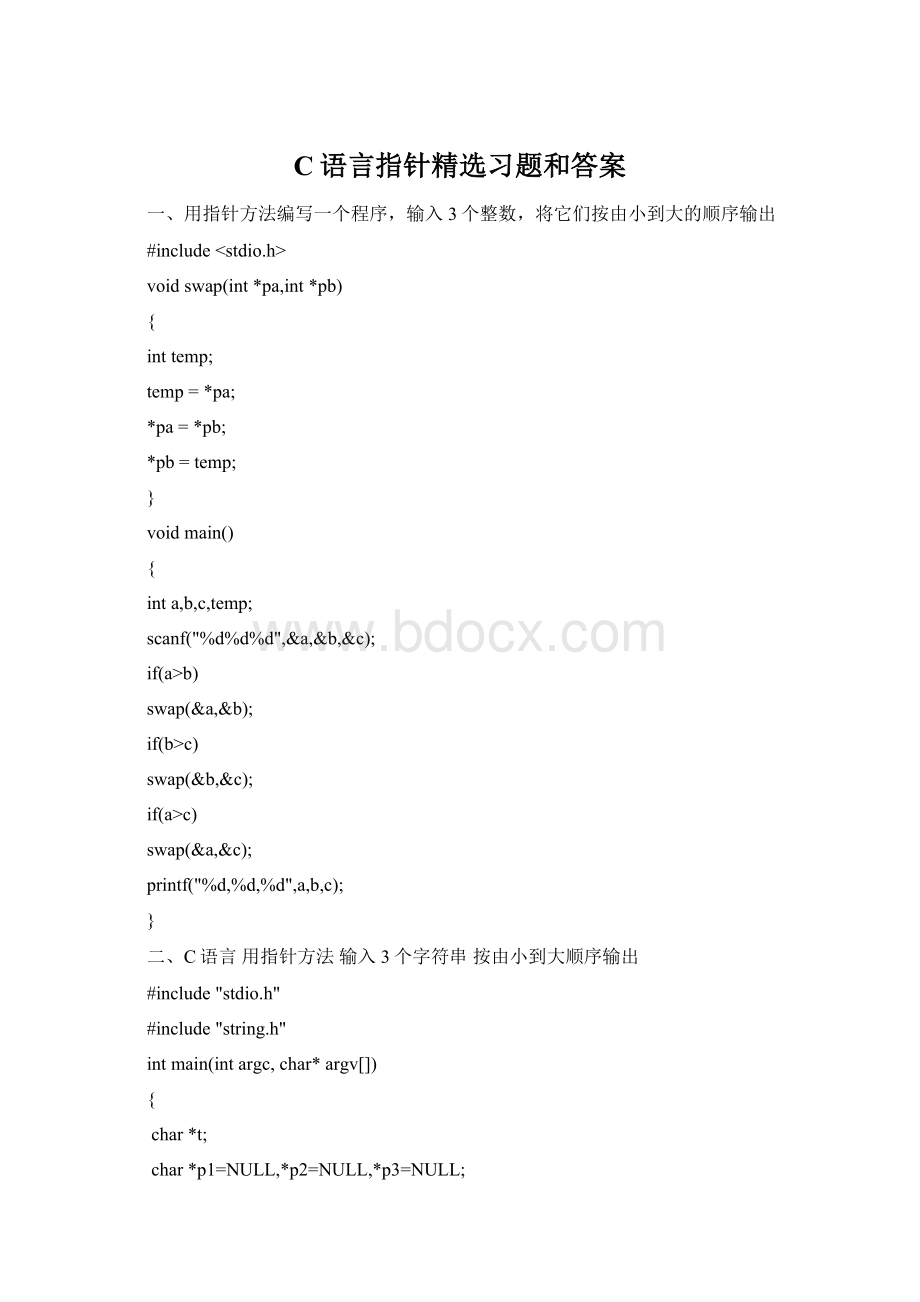C语言指针精选习题和答案.docx
《C语言指针精选习题和答案.docx》由会员分享,可在线阅读,更多相关《C语言指针精选习题和答案.docx(13页珍藏版)》请在冰豆网上搜索。

C语言指针精选习题和答案
一、用指针方法编写一个程序,输入3个整数,将它们按由小到大的顺序输出
#include
voidswap(int*pa,int*pb)
{
inttemp;
temp=*pa;
*pa=*pb;
*pb=temp;
}
voidmain()
{
inta,b,c,temp;
scanf("%d%d%d",&a,&b,&c);
if(a>b)
swap(&a,&b);
if(b>c)
swap(&b,&c);
if(a>c)
swap(&a,&c);
printf("%d,%d,%d",a,b,c);
}
二、C语言用指针方法输入3个字符串按由小到大顺序输出
#include"stdio.h"
#include"string.h"
intmain(intargc,char*argv[])
{
char*t;
char*p1=NULL,*p2=NULL,*p3=NULL;
charch1[20]={0},ch2[20]={0},ch3[20]={0};
p1=ch1;
p2=ch2;
p3=ch3;
printf("No1:
");
scanf("%s",p1);
fflush(stdin);
printf("No2:
");
scanf("%s",p2);
fflush(stdin);
printf("No3:
");
scanf("%s",p3);
fflush(stdin);
if(strcmp(p1,p2)>0)
{t=p1;p1=p2;p2=t;}
if(strcmp(p1,p3)>0)
{t=p1;p1=p3;p3=t;}
if(strcmp(p2,p3)>0)
{t=p2;p2=p3;p3=t;}
printf("%s\n%s\n%s\n",p1,p2,p3);
return0;
}
9.4编程输入一行文字,找出其中的大写字母,小写字母,空格,数字,及其他字符的个数
#include
voidmain()
{
inta=0,b=0,c=0,d=0,e=0,i=0;
char*p,s[20];
while((s[i]=getchar())!
='\n')i++;
p=s;
while(*p!
=10)
{
if(*p>='A'&&*p<='Z')
a++;
elseif(*p>='a'&&*p<='z')
b++;
elseif(*p=='')
c++;
elseif(*p>='0'&&*p<='9')
d++;
elsee++;
p++;
}
printf("大写字母%d小写字母%d\n",a,b);
printf("空格%d数字%d非字符%d\n",c,d,e);
}
9.5写一个函数,将33矩阵转置
#include"stdio.h"
voidTranspose(int(*matrix)[3])
{
inttemp;
inti,j;
for(i=1;i<3;i++)/*转置*/
{
for(j=0;j{
temp=*(*(matrix+j)+i);
*(*(matrix+j)+i)=*(*(matrix+i)+j);
*(*(matrix+i)+j)=temp;
}
}
}
voidmain()
{
inta[3][3]={{1,2,3},{4,5,6},{7,8,9}};
Transpose(a);
for(inti=0;i<3;i++)
{
for(intj=0;j<3;j++)
{
printf("%d",a[i][j]);
}
printf("\n");
}
}
}
9.6用指向一维数组的指针做函数参数
#include
#include
intmain()
{
voidsort(char(*s)[6]);//一维数组的指针做函数参数
inti;
charstr[10][6];
char(*p)[6];//定义一维数组的指针做函数参数
printf("pleaseinputstring:
/n");
for(i=0;i<10;i++)
scanf("%s",&str[i]);
p=str;//将str一维数组指针,赋值给p;
sort(p);
printf("theoutputsequence:
/n");
for(i=0;i<10;i++)
printf("%s/n",str[i]);
return0;
}
voidsort(char(*s)[6])//s指向一维数组的指针做函数参数;
{
inti,j;
chartemp[6],*t;
t=temp;
for(i=0;i<9;i++)//i应该小于9;如果小于10,那么就比较了9+1次;按照冒泡法则,
for(j=0;j<9-i;j++)//第一次比较需要9次就是i=0到i=8共九次;第二次需要比较8次;依次类推;
if(strcmp(s[j],s[j+1])>0)
{
strcpy(t,s[j]);
strcpy(s[j],s[j+1]);
strcpy(s[j+1],t);
}
}
9.7编一程序,用指针数组在主函数中输入十个等长的字符串。
用另一函数对它们排序,然后在主函数中输出10个已排好序的字符串
//用指针数组处理
#include
#include
intmain()
{
voidsort(char*[]);
inti;
charstr[10][6],*p[10];
printf("pleaseinput10string:
/n");
for(i=0;i<10;i++)//首先将10个str的首地址赋值给10个p[i];
p[i]=str[i];//将第i个字符串的首地址赋予指针数组p的第i个元素;
for(i=0;i<10;i++)
scanf("%s",p[i]);//scanf输入到&p[i]
sort(p);
printf("theoutput10string:
/n");
for(i=0;i<10;i++)
printf("%s/n",p[i]);//输出到p[i];
}
voidsort(char*s[])
{
char*temp;
inti,j;
for(i=0;i<9;i++)
for(j=0;j<9-i;j++)
if(strcmp(*(s+j),*(s+j+1))>0)
{
temp=*(s+j);//*(s+j)指向数组指针,我想应该是字符串的首地址;所以可以直接赋值给temp指针;
*(s+j)=*(s+j+1);
*(s+j+1)=temp;
}
}
9.8指针将n个数按输入时顺序的逆序排列,用函数实现
#include
voidreverse(inta[],intn)
{int*p;
for(p=a+n-1;p>=a;p--)
printf("%4d",*p);
printf("\n");
}
main()
{inta[20],n;
inti;
printf("Inputthelengthofarray:
");
scanf("%d",&n);
printf("Inputthenumberofarray:
");
for(i=0;iscanf("%d",&a[i]);
reverse(a,n);
}
9.9写一函数,实现两个字符串的比较。
即自己写一个strcmp函数,函数原型为:
intstremp(char*p1,char*p2)
设p1指向字符串s1,p2指向字符串s2。
要求:
当s1=s2时,返回值为0。
当s1不等于s2时,返回它们二者的第一个不同字符的ASCII码差值(如“BOY”与“BAD”,第二字母不同,“O”与“A”之差为79-65=14);如果s1>s2,则输出正值;如果s1#include
main()
{intstrcmp(char*p1,char*p2);
intm;
charstr1[20],str2[20],*p1,*p2;
printf("Inputtwostrings:
\n");
scanf("%s",str1);
scanf("%s",str2);
p1=&str1[0];
p2=&str2[0];
m=strcmp(p1,p2);
printf("result:
%d\n",m);
}
intstrcmp(char*p1,char*p2)/*两个字符串比较的函数*/
{inti;
i=0;
while(*(p1+i)==*(p2+i))
if(*(p1+i++)=='\0')return(0);/*相等时返回结果0*/
return(*(p1+i)-*(p2+i));/*不等时返回结果为第一个不等字符ASCII码的差值*/
}
运行情况如下:
①Inputtwostrings:
CHINA↙
Chen↙
Result:
-32
②Inputtwostrings:
hello!
↙
Hello!
↙
Result:
0
③Inputtwostings:
dog↙
cat↙
result:
1
9.10编一个程序,打入月份号,输出该月的英文月名。
例如,输入“3”,则输出“March”,要求用指针数组处理。
#include
main()
{char*month_name[13]={"illegalmonth","January","February","March","April",
"May","June","July","August","September","October","November","December"};
intn;
printf("Inputmonth:
");
scanf("%d",&n);
if((n<=12)&&(n>=1))
printf("Itis%s.\n",*(month_name+n));
else
printf("Itiswrong.\n");
}
运行结果:
①Inputmonth:
2↙
ItisFebruary.
②Inputmonth:
8↙
ItisAugust.
③Inputmonth:
13↙
Itiswrong.
9.11c语言:
将字符串computer赋给一个字符数组,然后从第一个字母开始间隔地输出该串。
请用指针实现
#include
#include
#defineMAX_LENGTH32
intmain()
{
charstr[MAX_LENGTH]={0};
char*pStr=(char*)&str;
//1.将字符串computer赋给一个字符数组
strcpy(str,"computer");
//2.然后从第一个字母开始间隔地输出该串
while(*pStr!
='\0')
{
printf("%c\n",*pStr);
pStr++;
}
return1;
}
9.12从键盘上输入一个字符串,按后按照下面要求输出一个新字符串,新的字符串是在原来字符串中,每两个字符之间插入一个空格,如原来的字符串为“abcd”,新产生的字符串应为“abcd”
编写一个程序咯用C就是输出的字符是每两个字符之间有一个空格
#include
voidmain()
{
chara[10],b[10],i=0,j=0;
printf("输出字符串");
scanf("%s",a);//abcdef
for(i=0;a[i]!
='\0';i++)
{
b[j++]=a[i];
b[j++]='';
}
b[j]='\0';
printf("%s",b);
}
9.13设有一数列,包含10个数,已按升序排好。
现要求编一程序,它能够把从指定位置开始的n个数按逆序重新排列并输出新的完整数列。
进行逆序处理时要求使用指针方法(例如:
原数列为2,4,6,8,10,12,14,16,18,20,若要求把从第4个数开始的5个数按逆序重新排列,则得到新数列为2,4,6,16,14,12,10,8,18,20。
)
#include
voidmethod(intn,intm,int*a)
{
int*p=a,*q=newint[m];
p=p+n-1;
for(inti=0;i{
q[i]=*p;
p++;
}
p=p-m;
for(i=0;i{
*p=q[m-1-i];
p++;
}
}
intmain()
{
inta[10]={2,4,6,8,10,12,14,16,18,20};
method(4,5,a);
for(inti=0;i<10;i++)
{
cout<}
return0;
}
9.3有一字符串,包含n个字符。
写一个函数,将此字符串从第m个字符开始的全部字符复制成为另一个字符串并输出
voidstrcpyn(char*s,char*t,intn)
{
char*p=s+n;
char*q=t;
while(*p)
{
*q=*p;
q++;
p++;
}
*q='\0';
}
main()
{
chars[100]={0};
chart[100]={0};
intn=0;
printf("inputstrings:
\n");
scanf("%s",s);
printf("inputstartn:
\n");
scanf("%d",&n);
strcpyn(s,t,n);
puts(t);
}
-
实验10
1.设计函数char*insert(s1,s2,n),用指针实现在字符串s1中的指定位置n处插入字符串s2
#include
char*insert(char*s1,char*s2,intn)
{
intj=0;
char*ss=newchar[100];
char*tsptr=ss;
for(inti=0;i*ss++=*s1++;
while(*s2!
='\0')
*ss++=*s2++;
while(*s1!
='\0')
{
*ss++=*s1++;
}
*ss='\0';
returntsptr;
}
voidmain()
{
chars1[]="123456789";
chars2[]="1234";
char*ss=insert(s1,s2,4);
printf("%s",ss);
}
2.利用指针完成字符串复制函数char*strcpy(char*s1,char*s2)
#include"stdio.h"
char*fun(char*s1,char*s2)
{char*p=s2;
while((*s1)!
='\0')
{
*s2=*s1;
s1++,s2++;
}
returnp;
}
voidmain(void)
{
char*p,*strcpy;
char*s1="worldcup!
";
char*s2="goodluck!
";
printf("s1=%s\ns2=%s\n",s1,s2);
p=fun(s1,s2);
printf("s1=%s\ns2=%s\n",s1,s2)
}
实验9
1.编写一个使用指针的c函数,交换数组a和数组b中的对应元素
#include
#include
voidex(int*a,int*b,intn){
inti,tmp;
for(i=0;itmp=a[i];a[i]=b[i];b[i]=tmp;
}
}
voidmain()
{
intx[5]={1,2,3,4,5};
inty[5]={6,7,8,9,10};
inti,n=5;
ex(x,y,n);
printf("\nX:
");
for(i=0;iprintf("\nY:
");
for(i=0;isystem("pause");
}